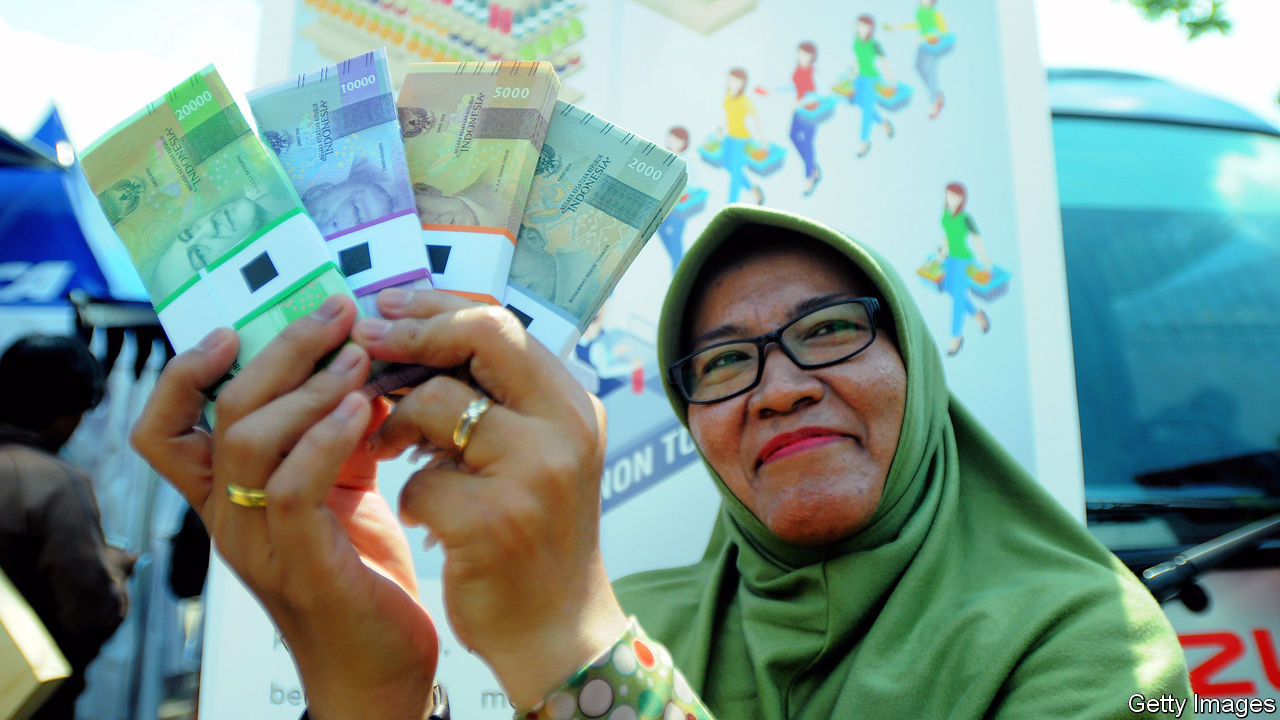Islamic institutions have a tiny share of the banking sector

THE Indonesia Stock Exchange greeted its latest listing on May 9th: that of BRIsyariah, the Islamic arm of state-controlled Bank Rakyat Indonesia, the country’s biggest bank by assets. The initial public offering (IPO) of 27% of BRIsyariah’s equity raised around 1.3trn rupiah ($92m). Islam outlaws the payment of interest, the basis of conventional banking. Yet despite being home to an eighth of the world’s Muslims—225m, in a population of 260m—Indonesia’s Islamic banks are tiny. They account for just 5.8% of all banks’ assets. In neighbouring Malaysia, which has been promoting Islamic finance for many years, Islamic banks’ share exceeds 25%.
But Indonesia’s are growing fast. According to the Financial Services Authority (OJK), the industry’s supervisor, last year their assets rose by 19%, against 9.8% for conventional banks. BRIsyariah’s IPO will help tackle what the OJK says is the biggest obstacle to their development: a want of capital. Indonesian regulation divides banks into four categories; the more tier-1 capital they have, the broader their range of permitted activities. Of the 13 Islamic banks run as separate entities from their conventional parents, none is in category 4—banks with capital above 30trn rupiah, which are permitted to operate globally. BRIsyariah expects to become only the second in category 3 (over 5trn rupiah and allowed to operate in Asia). Lack of capital, says the OJK, means fewer branches and dearer funding, which constrains Islamic banks to focus on retail rather than corporate customers.
To appeal, Islamic products must be competitive with conventional ones, says Mohamed Damak of S&P Global, a rating agency. But sharia banking is far from doomed to failure. Arsalaan Ahmed, the chief executive of the Malaysian subsidiary of HSBC Amanah, the bank’s Islamic division, says that 65-70% of his retail customers are not Muslim.
Last year Indonesia’s president, Joko Widodo, known as Jokowi, set up a committee to promote Islamic finance and establish Indonesia as a hub. In June the OJK published a two-year “roadmap”. The supervisory body is also promoting awareness of sharia products: a survey in 2016 found that only 6.6% of Indonesians understood them. A council of Islamic scholars established several years ago may help avoid disputes over whether products meet sharia standards. Whether it will be as successful as Malaysia’s, which is housed in the central bank and enjoys legal authority, is not yet clear.
Lack of scale, says Herwin Bustaman, head of sharia banking at the Indonesian arm of Maybank, Malaysia’s biggest lender, bedevils all small banks, not just Islamic ones. But some banks’ legal structures make matters worse. A bank may create either a separate entity for its sharia division (eg, BRIsyariah) or a “sharia business unit” (UUS) that uses the capital, branch networks and personnel of the parent (eg, Maybank). The latter, says Mr Bustaman, is much cheaper: he says he matches the returns and cost-income ratios of conventional banks. The UUSs’ non-performing loans are just 2.5% of the total, against 4.6% at stand-alone entities. Their return on assets averages 2.4%, versus 1.2%.
It would be hugely helpful, says Mr Bustaman, if the OJK embraced the UUS model. A law from 2008, however, points the other way. A UUS must be spun off once its assets are half those of its parent (only a handful, including Maybank’s, reach even 10%) or in any event by 2023. The OJK is preparing simpler regulation allowing subsidiaries to use their parents’ branches, computers and people. Letting UUSs continue might be simpler still.
Regardless of legal form, the fastest route to scale may lie in Jokowi’s ambitious infrastructure plans and in loans to big companies. Even handling a tenth of the many billions being splurged on roads, railways and so forth would double Islamic banks’ assets, Mr Bustaman reckons. Indonesia is already the top international issuer of sovereign sukuk (sharia-compliant bonds), points out Bashar Al-Natoor of Fitch, another rating agency, and this year sold the first “green” sukuk, raising $1.25bn, although Malaysia issues far more sukuk in all through its domestic market.
The OJK says it indeed expects Islamic banks to play a bigger role in infrastructure. It also envisages a special role for them in financial inclusion, microfinance and supporting small businesses—which, it says, will differentiate Indonesia’s model from those of Malaysia and the Gulf states. Yet financial inclusion is rising fast anyway. The share of Indonesians aged 15 and over with bank accounts leapt from 36% in 2014 to 49% last year, according to the World Bank. Conventional banks and Asia’s technology companies will also vie to serve them. Islamic banks have their work cut out.
No comments:
Post a Comment
Note: Only a member of this blog may post a comment.